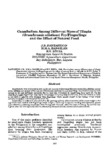Cannibalism among different sizes of tilapia (Oreochromis niloticus) fry/fingerlings and the effect of natural food
- Global styles
- MLA
- Vancouver
- Elsevier - Harvard
- APA
- Help
Share
抄録
Experiments were conducted in jars, tanks and aquaria to determine the occurrence of cannibalism among 7 different size groups of Nile tilapia (Oreochromis niloticus ) fry and fingerlings. Cannibalism became more intense as the size difference increased. Big fry were less susceptible to cannabalism than small fry. On the other hand, bigger fingerlings were highly cannabalistic compared with smaller ones. This was evident as early as the first 10 minutes after stocking when fingerlings which usually stayed at the bottom moved swiftly towards the surface and swallowed the smaller fry.
Availability of additional natural food in the growing medium affected survival of fry (mean weight = 9.3 mg) which were stocked with fingerlings (mean weight = 163.5 mg) in aquaria. Feeding with Spirulina proved more effective in reducing cannibalism than feeding with Navicula . After 5 days of rearing, fry survival was highest when fed with Spirulina (83.1%) followed by Navicula (16.6%) and the unfed control (5.6%).
Suggested Citation
Pantastico, J. B., Dangilan, M. M. A., & Eguia, R. V. (1988). Cannibalism among different sizes of tilapia (Oreochromis niloticus) fry/fingerlings and the effect of natural food. In R. S. V. Pullin, T. Bhukaswan, K. Tonguthai, & J. L. Maclean (Eds.), The Second International Symposium on Tilapia in Aquaculture (pp. 465–468). Bangkok, Thailand: Department of Fisheries; Manila, Philippines: International Center for Living Aquatic Resources Management.
Type
Conference paperISBN
9711022605Collections
- Conference Proceedings [299]


